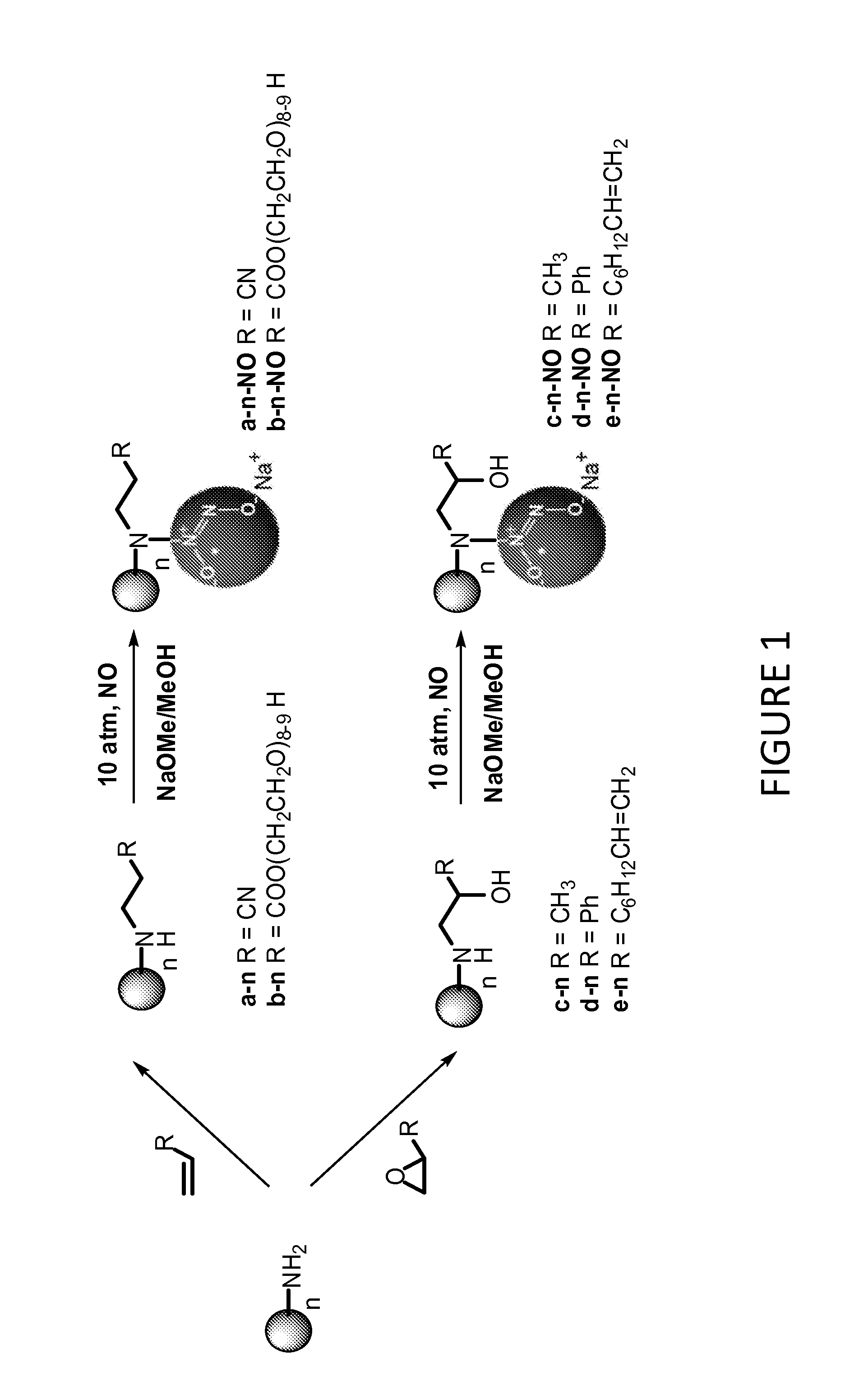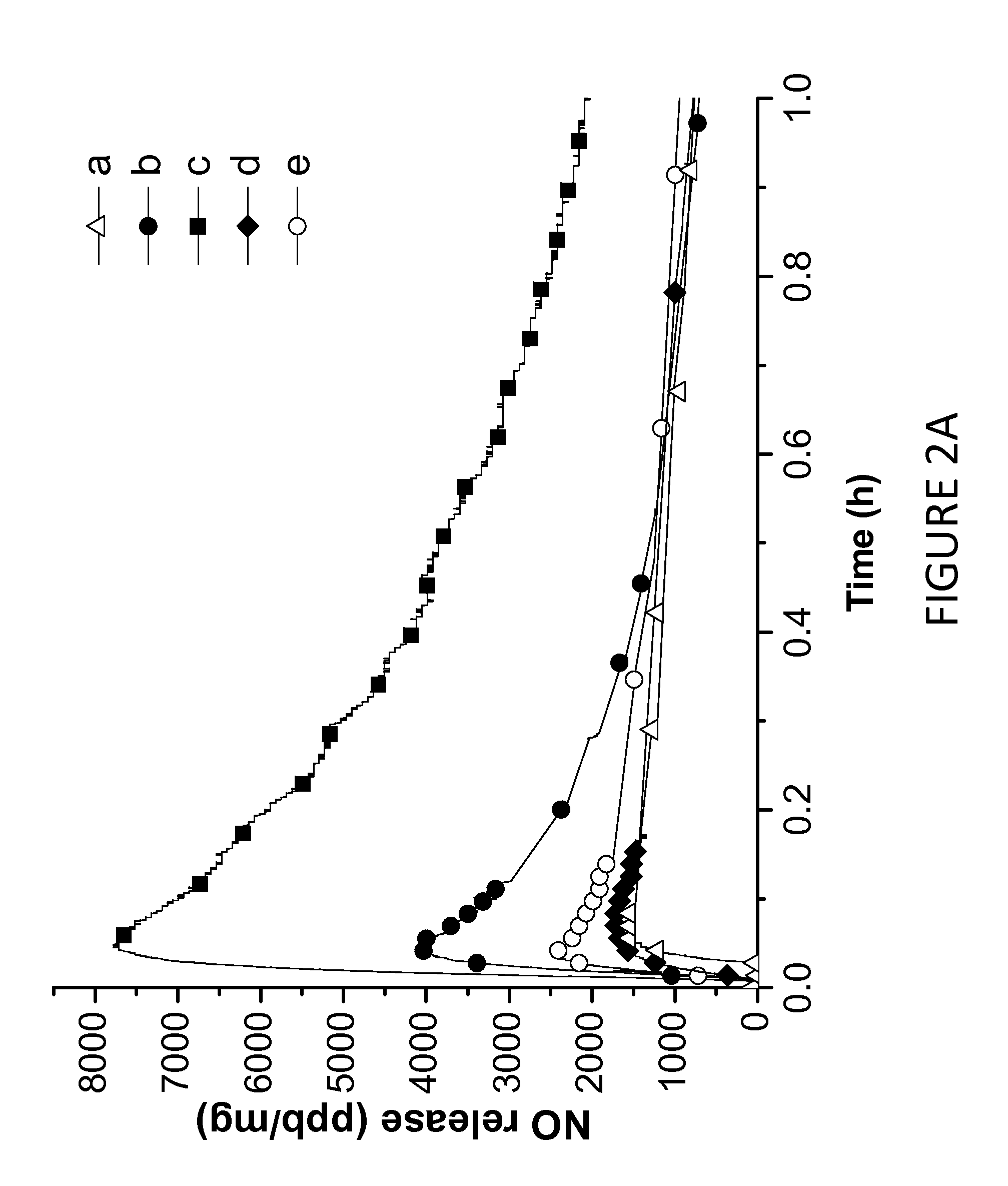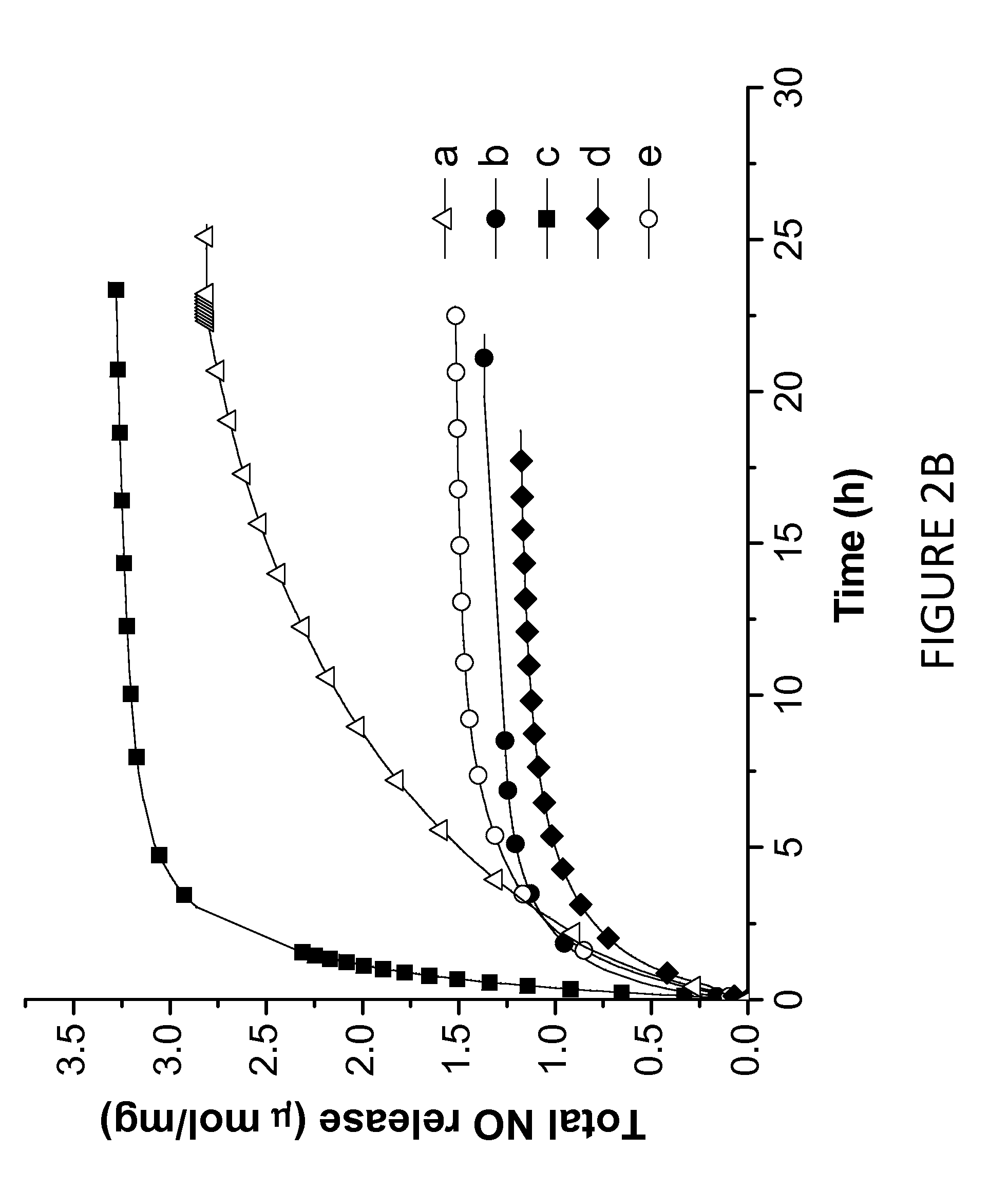Tunable nitric oxide-releasing macromolecules having multiple nitric oxide donor structures
a macromolecule and nitric oxide technology, applied in the field of compound nitric oxide release, can solve the problems of not being able to achieve clinically viable solutions for administering nitric oxide outside of its gaseous form, and being difficult to use nitric oxide in a therapeutic setting
- Summary
- Abstract
- Description
- Claims
- Application Information
AI Technical Summary
Benefits of technology
Problems solved by technology
Method used
Image
Examples
example 1
Synthesis of [G-0.5]-PPI-CN to [G-4.5]-PPI-CN
[0099]For the synthesis of [G-0.5]-PPI-CN, ethylenediamine (EDA, 25.0 mL, 0.374 mol) and deionized water (263 mL) were placed in a 1000 mL round-bottomed flask. Acrylonitrile (ACN, 140 mL) was added in portions of 20 mL with stirring for 15 min. The resulting mixture was refluxed for 2 h, and then cooled to room temperature overnight. ACN was removed in vacuo at 40° C. [G-0.5]-PPI-CN was crystallized from the mixture and isolated by vacuum filtration. The crude product was recrystallized from THF / methanol as a white powder.
[0100]Representative 1HNMR data was as follows: (300 MHz, CDCl3): δ(ppm) 2.55 (8H, NCH2CH2CN), 2.77 (4H, —NCH2CH2N—), 2.96 (t, 8H, —NCH2CH2CN). Synthesis of higher generation PPI-CN (e.g., from [G-1.5] to [G-4.5]) was not significantly different from the synthesis of PPI-[G-0.5]-CN as described above, with the exception that PPI-CN (e.g., from [G-1.5] to [G-4.5]) were usually viscous liquids and their purification proce...
example 2
Synthesis of [G-1]-PPI-NH2 to [G-5]-PPI-NH2
[0101]For the synthesis of [G-1]-PPINH2, sponge cobalt catalyst (5.0-6.0 g) was washed with 10% KOH solution for 10 min, three times with de-ionized water, and twice with methanol prior to use. [G-0.5]-PPI-CN (10.0 g) was placed in a glass reactor sleeve and dissolved in THF (70 mL) and methanol (30 mL). To this solution, the sponge cobalt catalyst prepared as described above (5.0-6.0 g) was added using a pipet. The reactor sleeve was then placed in the hydrogenation chamber with proper stirring. The reactor was purged with house nitrogen (60 PSI) five times, and then with hydrogen (400 PSI) twice. The reactor was charged with hydrogen to a pressure of 800 PSI, and heated to 100° C. The hydrogen gas pressure was maintained at 1000 PSI throughout the reaction. After 3 h, the reaction mixture was cooled to room temperature. Hydrogen was slowly removed, and the reaction chamber was purged once with house nitrogen. The resulting reaction mixtur...
example 3
Synthesis of Secondary Amine-Functionalized PPI Dendrimers
[0103]100 mg PPINH2 (e.g., from G2 to G5) was dissolved in 2 ml methanol in a 10 ml vial. One equivalent of acrylonitrile (ACN), poly(ethylene glycol) methyl ether acrylate (average Mn=480) (PEG), propylene oxide (PO), styrene oxide (SO), or 1,2-epoxy-9-decene (ED) (e.g., with respect to molar amount of primary amine functionality) was then added to the 10 mL vial. The solution was stirred at room temperature for 4 days. Solvent was removed under reduced pressure. Dendrimers were dissolved in water followed by dialysis against water and lyophilization.
[0104]Representative 1H NMR data of secondary amine-functionalized G5-PPI conjugate formed via the reactions of G5-PPI-NH2 with ACN, PEG, PO, SO, and ED (referred to hereafter as G5-PPI-ACN a-64, G5-PPI-PEG b-64, G5-PPI-PO c-64, G5-PPI-SO d-64, G5-PPI-ED e-64) were as follows: G5-PPI-ACN a-64: 1H NMR (400 MHz, CD3OD, δ): 2.87 (NHCH2CH2CN), 2.82 (NHCH2CH2CN), 2.60 (NCH2CH2CH2NH),...
PUM
| Property | Measurement | Unit |
|---|---|---|
| pH | aaaaa | aaaaa |
| half life | aaaaa | aaaaa |
| half life | aaaaa | aaaaa |
Abstract
Description
Claims
Application Information
 Login to View More
Login to View More - R&D
- Intellectual Property
- Life Sciences
- Materials
- Tech Scout
- Unparalleled Data Quality
- Higher Quality Content
- 60% Fewer Hallucinations
Browse by: Latest US Patents, China's latest patents, Technical Efficacy Thesaurus, Application Domain, Technology Topic, Popular Technical Reports.
© 2025 PatSnap. All rights reserved.Legal|Privacy policy|Modern Slavery Act Transparency Statement|Sitemap|About US| Contact US: help@patsnap.com



